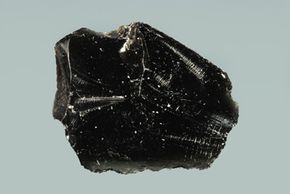The Basics: Glass Formation
Before we learn about the transparent armor of tomorrow, we're going to learn about the transparent armor of today's most basic component: glass. Understanding how glass forms will help us to later understand how we can see through an aluminum alloy.
Natural heat-producing processes like volcanoes and lightning strikes are responsible for creating various forms of glass, like obsidian, which is just super-heated sand or rock that has rapidly cooled. Humans once used this type of natural glass for decoration, money and the tips of spears or arrows, but before long, ingenious humans discovered their own process for making glass.
Advertisement
Carved into stone tablets about 5,000 years ago in Mesopotamia, the formula still holds true today: You take common sand (silica), soda and lime, mix it up, heat it, shape it into the desired form and cool it back down [source: Martin].
While the glass-making process is more involved than either Pliny or we describe it, this is the basic formula. So we know how it's made, but we don't know why you can see through it. The answer is entirely relevant to how aluminum armor -- which we'll talk about soon -- can be made transparent. When the ingredients of glass are heated, they melt and become liquid.
This change of states is important. Solids are rigid and opaque for a reason -- the molecules that form a solid are aligned with one another, creating a strongly bound lattice of sorts. When a solid turns into a liquid, the lattice loosens as the molecules randomly align with each other. This less orderly molecular structure becomes even more pronounced as the material becomes a gas. This flimsy arrangement of molecules allows light to pass through gases and liquids.
The process of heating and cooling the glass ingredients transforms them into a molecular stew and solidifies them in that same liquidlike state with all of the molecules unaligned with one another, enabling light to pass through the hardened glass. For more on this interesting subject, read What makes glass transparent?
Now we know what glass is, how to make it and why it's transparent. So why doesn't glass stop .50-caliber bullets or a handful of stones? Find out next.
